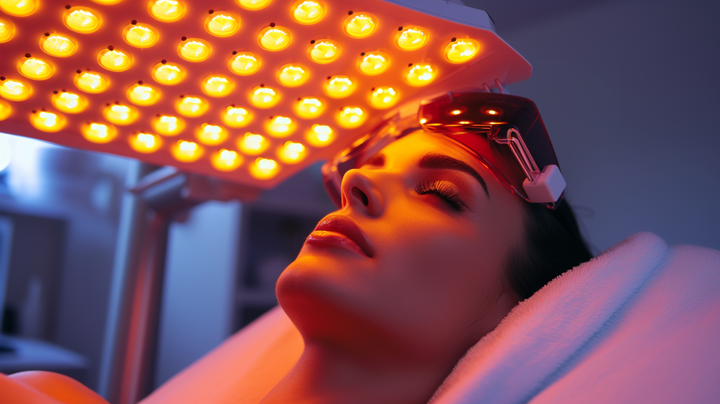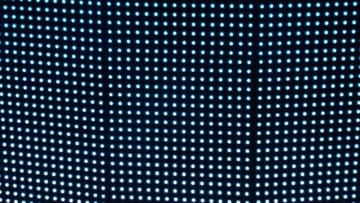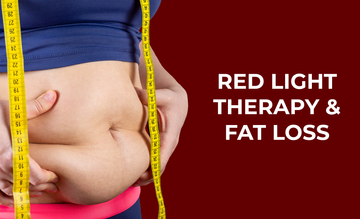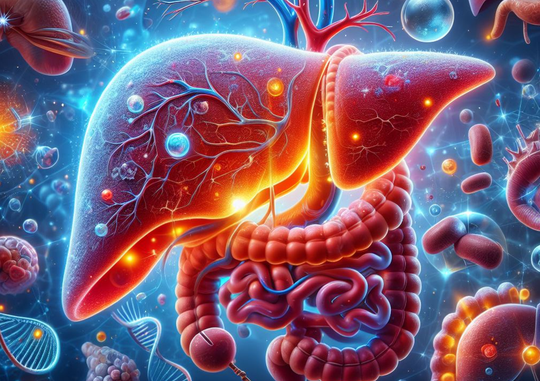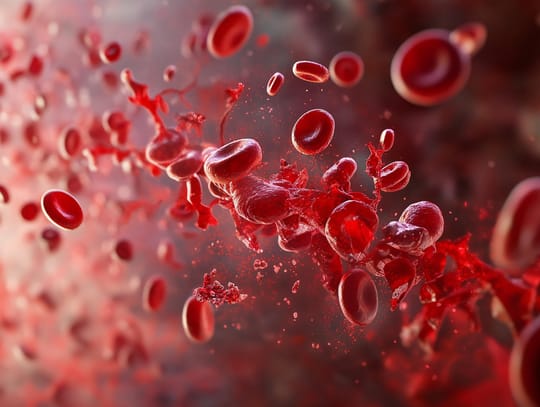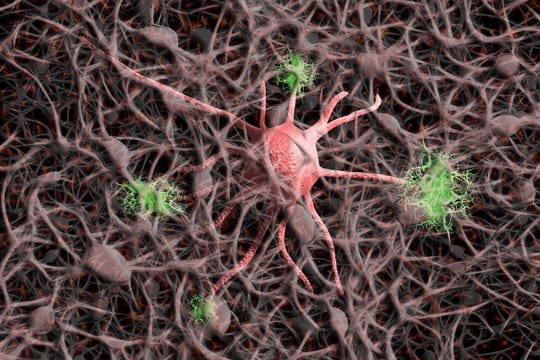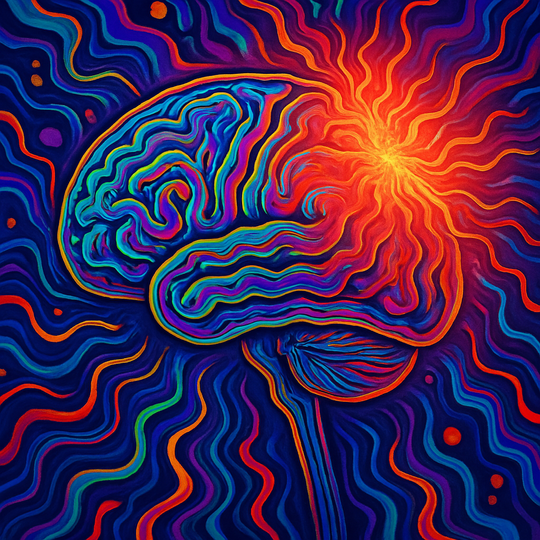Welcome to my 590nm wavelength health effects guide - you'll learn about the very interesting effects of this unique wavelength.
Recently Mito Red has become the first company to incorporate 590nm light into their new MitoPRO X panels (if you grab a panel make sure to use discount code ALEX5). I think that choice is great and you'll learn why in this blog post.
But's let's first explore what 590nm fundamentally is:
What Is 590nm Light: Is It Amber, Yellow, Or Green Light!?
Often, 590nm light is described as being "amber" in color. But other times the 590nm is also called yellow, and sometimes even green (as many people categorize green light ranging from 500-600nm).
For convenience's sake, I'll consider 590nm amber, not green or yellow. It doesn't matter, though, what you call the wavelength, as color is in the eye of the beholder for humans and the technically correct way to talk about it.
Nevertheless, let's look at all of the published literature on 590nm light. I've used Vladimir Heiskanen's excellent datasheet that contains most red light therapy studies for that purpose.
590nm Wavelength Health Effects
Here are all the 590nm wavelength health effects:
1) May Boost Recovery After Bone Fractures
So you can't be 100% sure with this study as it used a combination of 590nm and 830nm light (1). The study looked at edema in people with bone fractures. Here's the self-described cause by the study authors:
"The fracture sites included the nasal bone, orbital wall, zygomaticomaxillary bone, mandible, and frontal sinus. Mechanisms of injury included fall, assault, traffic accident, sports, and gunshot. " (1).
The study also notes that the red light therapy can aid in skin rejuvenation, wound healing, and pain.
But here, a 16.7% reduction in edema buildup was found in the group treated with red light therapy and a 7.3% in the group receiving the placebo (sham treatment). So the light therapy group achieved double the result.
Treatment occured after the accident, twice per day, for five days. So these results are achievable in less than a week. The problem, however, is dinstinguishing between the effects of 590nm and 830nm light.
Other in vitro studies also show that 590nm can change the gene expression of fibroblasts (46). 590nm light has a stronger effect than 870nm light, in that case. "Gene expression" concerns the activation and deactivation of genes.
2) Doesn't Affect Energy Metabolism And May Influence Cell Material Recycling (Autophagy)
Then, another study investigated the effects of 590nm light, among others, on energy metabolism in relation to bone (2). Six wavelengths were used: 450nm, 490nm, 550nm, 590nm, 650nm and 850nm.
The aim was to find out how fibroblasts, human skin cells, responded to the light. The downside here is that it's an "in vitro" study, meaning "in the glass", like you may remember from chemistry in high school. Such studies don't always translate to real human outcomes.
Here, the blue light created reactive oxygen species (ROS) that may imply damage - but only at higher dosages. Wavelengths above 590nm had a neutral effect. 850nm light had the best stimulatory effect for energy production.
This study isn't too important in isolation though and more research is needed.
Yet one more study investigates the effect on cell senescence (3). Senescent cells need to be recycled through a process called autophagy, because they don't function properly anymore.
This is yet another in vitro study though. The study setup was as follows:
"Human dermal fibroblasts were irradiated by a panel of light-emitting diodes with 590 nm and dose 30 J/cm2 accumulated over 1200 sec repeated in 4-day cycle within 40 days. After the last cycle of PBM treatment, the difference in number of senescent cells between PBM treated groups end nontreated control groups was measured by senescent sensitive β-galactosidase assay, and the difference in average telomere length between the experimental end control groups was analyzed using relative human telomere length quantitative Polymerase Chain Reaction (qPCR) assay" (3).
The result? With ten cycles of irradiation at 30 J/cm2, there were fewer senescent cells in the fibroblast group that got irradiated by 590nm light.
3) Promotes Skin Rejuvenation And Skin Health
In this section, I'll explore the effect of 590nm light on skin health and rejuvenation. While it's a long section, I'll hereby summarize the effects that 590nm can have on your skin:
- Lower skin redness.
- Impeded inflammation in the skin.
- May counter melasma (hyperpigmentation of the skin)
- Counters skin side effects of cancer treatment (radiation), by countering radiation dermatitis (side-effect of cancer treatment).
- May counter rosacea (more research is needed).
- May impede scar formation (more research is needed here too!)
- Slower skin aging and likely lower photoaging effects (such as from overexposure to ultraviolet light)
- May reduce sunburn intensity and may speed up sunburn healing
So next up, there's a study that combines 590nm and 630nm light (4). Here, skin quality, as measured from the keratinocytes in the skin, indicates that combining both wavelengths may yield superior results for skin quality.
Once again, this is an in vitro study that shouldn't be considered that important but still it's an interesting observation. Cell shape, the proliferation of cells, and the protein makeup of cells was superior when 590nm and 630nm light were combined.
Fortunately, there are also human studies on 590nm light (5). All participants in this study received an "intense pulsed laser" (ILP) treatment. The goal with ILP is to improve skin health without resorting to surgery. Study participants were rated on redness immediately after ILP treatment, 24 hours later, and one week later.
The result? Skin redness was reduced by about 20% on the side of the face that was treated with 590nm light around the ILP treatment. For all participants, there was no redness after a week. Overall though, it seems that 590nm has a protective effect against skin damage and reduces redness.
This is also a human study, meaning that there's the first evidence that 590nm really works for skin rejuvenation.
Another study investigates a very similar topic here (6). Here, 590nm, 630nm, plus 850nm are used together. No effect on water content of the skin or redness was found here with the LED treatment.
Then, one more study also looks at skin redness (7). 590nm and 830nm light were used here. Those lights were used after laser treatment for skin rejuvenation purposes - that laser treatment often comes with side effects such as a period that's needed for recovery.
Here too, again, one side of the face was treated with the 590nm and 830nm light combination. There was also a control group that didn't receive any LED therapy. For the participants that received LED treatment at one side of the face, no difference in redness and other parameters was found.
The 590nm and 830nm treated group did do better though than the group that didn't receive any LED treatment with less overall redness.
I'm also not fully convinced that this study setup is perfect as you'll probably get some systemic benefits on the untreated side of the face. So a LED treatment versus non-LED treatment comparison is probably best here, without having to resort to split-face treatments.
One more study investigates 590nm light alone, without any additions, for redness and edema after laser treatment (8). Here too, study participants were split with one part of the face treated and the other half untreated.
Once again, less redness was found in the facial half treated with 590nm light. Not only the intensity of the redness but also the duration was reduced.
Then, besides redness, there are also studies on melasma. Melasma is a darker discoloration of the skin (9; 10; 11). Melasma is a very complex problem that doesn't have an easy explanation. There's no simple cure available, either.
Nevertheless, 590nm light may help counter melasma (12). The vascular system may play a role in melasma. First up, the 590nm light may positively affect many of the underlying physiological processes in melasma. Researchers write:
"We investigated the effect of 590 nm LED on the function of human microvascular endothelial cells (HMEC-1). We revealed 0-40 J/cm2 590 nm LED had no toxic effect on HMEC-1 in vitro. 590 nm LED irradiation significantly reduced cell migration, tube formation, as well as the expression of vascular endothelial growth factor (VEGF) and stem cell factor (SCF), a pro-melanogenic factor." (12).
These outcomes are based on in vitro research. But, the researchers also conducted a study on humans that found reductions in redness once again, but also improvements in pigmentation for melasma patients!
This was after an eight-week treatment period.
And there are more skin health benefits from 590nm light (13). Radio dermatitis - a side effect of cancer treatment - is one of them. Radio dermatitis originates from radiation therapy for lung cancer or on the lymph nodes.
In the study, patients received 590nm light three times per week during radiation therapy. The severity of radiation dermatitis was reduced in the patients who received the 590nm light treatment.
Another study had a different outcome but the light may have been underdosed, according to Heiskanen's comments (14). This study included patients with breast cancer (14).
Another study had the same group of participants - patients with breast cancer - and did find that the 590nm was healing and reduced the effects of radiation dermatitis (15). Here's the extremely significant outcome described by the researchers:
"In LED-treated patients, 18 (94.7%) had grade 0 or 1 reaction and 1 (5.3%) had grade 2 reaction. Among controls, 4 (14.3%) had a grade 1 reaction, 24 (85.7%) had a grade 2 or 3 reaction." (15).
The higher the grade of the reaction, the worse the outcome. So in the LED-treated group, almost nobody had a bad reaction (of 2 or above). In the non-LED treated group, many had a grade 2 or 3 reaction. The effect of 590nm light on radiation dermatitis is thus potentially huge.
Next up, let's talk about rosacea, another skin condition affecting many.
In a mouse study, 590nm and 830nm light was used (16). Redness scores and the inflammation measured on the rosacea sites went down. The underlying blood vessel creation process that plays a role in rosacea was also impeded. And, the immune system functioning was normalized.
Rosacea is an inflammatory condition that has a strong immune component (17; 18; 19). The disease affects up to 10% of the world's population and lowers quality of life, so such studies as the one I've discussed above are extremely helpful! But, red light therapy is mostly side-effect free and by affecting rosacea through three mechanisms - inflammatory, immunological, and blood vessel creation - it's a very promising treatment!
More human research is needed though...
Next up, 590nm was studied in humans for scar prevention (20). Here too an effect was found, fortunately, with a 590nm and 830nm light combination.
A scale, the Vancouver Scar Scale (VSS), was used to assess the scars more objectively. The treatment group had significant improvements over the placebo group in this area. Coloration was also overall better in the treatment group. Participants were treated three times per week for three weeks.
Next up, combining 590nm and 660nm light may lower wrinkle volume by 30% in total (21). The wrinkles around the eyes were the main object of study here.
The study included 137 women and used a split-face setup but for each wavelength. So one part of the face was treated with 590nm and the other with 660nm light. The women had ages between 40 and 65 and received ten treatment sessions over four weeks. The light intensity was 3.8 J/cm2, which is a great skin dosage.
The red light caused a reduction of 31.6% wrinkle volume while the 590nm amber light caused a 29.9% reduction. So both light types have almost the same outcome for wrinkle reduction.
Then there's another study on skin rejuvenation (22). Fortunately, here only 590nm light was used, so not a combination of wavelengths. The participants were evaluated after four weeks, and evaluations continued up to a year. Treatment only lasted four weeks, twice weekly.
Digital imaging was used to measure the improvements in skin quality. 90% of study participants showed decreases in skin aging. The skin became smoother, the quantity of wrinkles decreased, and pigmentation improved. Collagen levels in the skin were also enhanced.
Yet another study that exclusively uses 590nm shows similar results, with reductions in skin aging in 90% of participants (23). Redness, pigmentation, and wrinkle quality improved here. None of these skin rejuvenation studies also show any side effects.
Next up, I'll shift topics slightly, and consider damage to the skin because of ultraviolet light exposure. My position on this topic is that ultraviolet light exposure is extremely important for optimal health, if and only if you get the dose right. Some exposure on the naked skin and naked eyes is far better than none or a lot of exposure.
Nevertheless, you'll want to be able to protect yourself against excessive damage from ultraviolet light exposure. And, that's specifically what 590nm does, it protects against damage of ultraviolet light - at least in an in vitro study (24).
If you're a nerd, you may want to read the explanation in the abstract of the study:
"Photoageing was induced in cultured human dermal fibroblasts (HDFs) using UVB irradiation of 50 mJ/cm2 . Then, the photoaged HDFs were irradiated with LED using a custom-built 590-nm LED device which emits light with an intensity of 38 mW/cm2 (irradiated for 900 s with 34.2 J/cm2 of total energy). LED irradiation significantly attenuated UVB-induced reactive oxygen species generation and UVB-induced phosphorylation of JNK, c-Fos and c-Jun. In addition, the procollagen levels were recovered significantly, and MMP-9 levels were significantly suppressed after LED irradiation. The UVB-induced phosphorylation levels of NF-κB and pro-inflammatory enzyme COX-2 also significantly decreased. Our results suggest that 590-nm yellow light irradiation may be an effective and safe anti-oxidative and anti-inflammatory treatment modality for photoaged skin." (24).
So to put it simply, 590nm light countered oxidative stress and inflammation that resulted from ultraviolet light exposure. Hence, amber (or yellow as the researchers name it here!) may protect against photoaging of the skin.
Another in vitro study has a very similar outcome (25). Here, a different ultraviolet light type was used (UVA) but again oxidative stress is lowered.
Some human studies do investigate the effects on photoaging in the skin, though (26). This study tracked 3,500 treatments in 900 different patients over a two year period with 590nm light.
Treatments were applied for skin health purposes alone or after other skin treatments, such as laser treatments. The researchers write in the full paper that:
"Patients who received LED photorejuvenation alone without concomitant treatment reported that they observed a softening of skin texture and a reduction in roughness and fine lines that ranged from a significant reduction to sometimes subtle changes. Improvement was noted by 90% of patients, with only 10% reporting themselves as nonresponders. Similar to previous reports, 60% of patients were noted in the treatment record by the physician to demonstrate global improvement in a combination of facial texture, fine lines, background erythema, and pigmentation." (27).
So, those are impressive improvements across the board. For people who had received other skin-based treatments such as lasers, the 590nm light also led to improvements such as decreased redness and inflammation.
The study also states that wound healing speeds up by a whopping 50% (27). And, there were benefits for countering sunburn. Researchers write:
"Ten patients received LED treatment for acute sunburn using a once- or twice-daily treatment regimen for 3 days and treating only half of the affected anatomic area. Decreased symptoms of burning, redness, swelling, and peeling were observed" (27).
So, that's a very nice benefit, right?! The study also states that benefits for people with eczema were found but doesn't go into much detail there.
Another study shows wound healing benefits after abdominial surgery, although the study setup is imperfect (58). The study used 520nm, 590nm, and 645nm light.
Scarring after surgery was reduced in that study (58). One more study showed the same result, with decreased pain (59).
Overall though, the research that's available right now in 590nm for skin rejuvenation and health is very impressive. I'd love to see more human research emerge in the coming years and decades!
Next up:
4) May Enhance Eye Health, Such As In Age-Related Macular Degeneration And Dry Eyes
So let's talk about eye conditions.
Age-related Macular Degeneration (AMD) is currently the leading cause of blindness in the world (28; 29; 30; 31). In that case, deposits in the eye cause progressive blindness. Many different factors influence the development and the course of the illness. Also, no treatment is currently accepted as being able to reverse the condition.
So in this study, 590nm, 660nm and 850nm were used to counter AMD (32). Study participants got two treatments per week for five weeks. Scientific equipment was used to measure the health of the eyes. The researchers conclude the following:
"The visual and anatomical improvements in our patients support previous reports on PBM. PBM may provide a valid therapeutic option for large soft drusen and drusenoid pigment epithelial detachment age-related macular degeneration and may potentially slow the natural course of the disease." (32).
Also, the Drusen deposits causing the AMD reduced in volume and thickness. So AMD may be slowed down or even reversed. The expert in red light therapy, James Carroll, claims that AMD is one of the areas in which red light therapy is best proven. I don't know yet, as I'd need to go through the research myself.
Nevertheless, the outcome above is very promising for eye health! And it's not the only study with that setup. Another study that combines 590nm, 660nm, and 850nm has a similar outcome (33).
This study used nine treatments over the course of 3-5 weeks, for a period of 24 months in total. So here you've got a true long-term effects study.
Here the clinical outcome of AMD improved significantly over placebo. The researchers used a visual acuity test, the one that you'll get when you're going to buy glasses. There was a 2.4-letter difference between the red light therapy group and the sham group, which is huge.
One more study once again has the same three wavelengths - 590nm, 660nm, and 850nm (34). Here there was an incredible 4-letter gain in the group treated with red light therapy, versus .5 in the placebo group.
The key here is that even within the same participants, not all eyes were treated with light. So, an eye treated with 590nm light may improve a lot while the other eye of the same study participant may show barely any improvement at all.
Another trial by the same group of researchers had the same outcome (35). There too incredible gains were made, with more than a third of study participants gaining improving their ability with 5 letter or more after 9 months of therapy. Let's now consider a few more trials on AMD:
- A combination of 590, 660, and 850 showed even more benefit, with 50% of treated eyes having a 5-letter improvement (36). That's after one month and in time the improvements were even far better. You will need to repeat light therapy though to maintain the benefits - and this is only in the early stages of AMD!
- Another study uses 590, 670, and 760nm light (37). Here a 6-letter improvement was reached after just three weeks. Treatment occurred three times per week.
So overall the outcome for AMD is extremely positive. Next up, let's look at dry eyes (38). The researchers took many standardized tests that are commonly used for dry eyes:
"The primary endpoint was the changes in the fluorescein corneal staining (FCS) score. The secondary endpoints were the changes in the ocular surface disease index (OSDI) score, lissamine green conjunctival staining (LGCS) scores, tear film break-up time (TBUT), Schirmer test, and the meibomian gland dysfunction (MGD) index. These were evaluated before treatment and 4 weeks after start of treatment" (38).
Treatment occurred three times per week for two weeks. Some of the tests improved in the treatment group, such as the LGCS, Schirmer's test and the upper meibography scores. The other tests didn't show any improvement.
But overall, there seems to be some benefit of red light therapy for dry eyes. A combination of 590nm and 830nm was used in this study.
Dry eyes is a complex multifactorial disease that has an oxidative stress and inflammation component (39; 40; 41). And because red light therapy affects both inflammation and oxidative stress, it's likely that there's a biological mechanism by which dry eyes can be countered here.
Then there's another eye condition, Reticular Pseudodrusen (RPD). RPD is a subvariation of AMD (42; 43; 44). In this subtype of AMD, a combination of 590nm, 660nm, and 850nm light doesn't have proven benefits (45).
Moving on:
5) May Help Counter Hair Loss
So in a study, predominantly 590nm light was used, with some 870nm light. The study had two different setups (47).
In the first setup, 590nm was pulsed for 70 seconds three times per week. In the second study, 590nm light was combined with a drug called Minoxidil. The outcome of the study is as follows:
"In the first clinical study, whole-genome analysis of treated scalp biopsies showed downregulation of scalp inflammatory biomarkers, such as AP1/FOSB messenger RNA (mRNA) and mir21, together with the disappearance of CD69 mRNA, specific to scalp-infiltrating T cells of about 50% of the studied volunteers prior to the LLLT/GentleWaves® treatment. In the second clinical study, we observed that LLLT/GentleWaves® was able to boost the hair regrowth activity of a Minoxidil 2% lotion to the extent of the highest concentration (5%) in terms of efficacy, number of responders, and perceived performance." (47).
So the 590nm wavelength is beneficial for countering hair loss, specifically androgenetic alopecia. The 590nm light improves hair loss more than just taking the prescription medicine without the 590nm light. Check out my blog on red light therapy for hair loss if you want to know more about this topic.
6) Varying 590nm Effects
Some other effects exist as well, that I've not been able to place in the other sectinos above:
- Improves liver regeneration after part of the liver has been removed in rats (48; 49). Interestingly enough, in one study, blue, green, and yellow (amber?) light had a stronger effect than red light even (50)! What's very interesting is that 590nm light also seems to stimulate mitochondrial activity directly, perhaps contrary to popular belief with the mitochondrial absorption spectra that most people place around 630nm light (51).
- Also, 590nm light seems to have a direct effect on Nitric Oxide (NO) (52). That study helps you learn a bit more about the biological mechanism of how 590nm light stimulates mitochondrial activity - it seems that NO is the mechanism by which activity improves, but doesn't lead to a direct increase in oxygen consumption (which is necessary for energy-creation in the mitochondria). NO plays a foundational role in human health, such as in blood vessel elasticity and the energy-creation process in your mitochondria (53; 54; 55). Physical exercise improves the NO systems in the body, for instance, as do green leafy vegetables, red light, but also 590nm amber light, apparantly.
- 590nm light may help dental implant stability, although 590nm light was one of the many wavelengths used in a study (56). The study used 470nm, 525nm, 590nm, 620nm, 680-760nm and 820nm. I just included this study for completeness' sake so that you know that nothing has been missed!
- A combination of 590nm and 830nm light did not affect knee pain (57). Most outcomes in the study weren't changed.
And that's it! All 590nm light studies broken down!
Best 590nm Red Light Therapy Products
So I didn't really plan on writing this blog post. And currently there's just one of the bigger companies as far as I know that offers 590nm light. That's Mito Red with the MitoPRO X series.
If you want a MitoPRO X panel then discount code ALEX5 saves you. Nevertheless, this is the only 590nm panel on the market right now. So I can't make this section much more complicated as it is - I've also written this article because Mito Red came out with their panel.
Conclusion: The Best Is Yet To Come?
There's not much research on 590nm as a wavelength. And yet, for eye and skin health, the effects are very promising. Hopefully hundreds if not thousands of studies are carried out on this wavelength over time.
And, with those studies, I'm pretty sure we'll find many other health effects that are currently undiscovered. In my mind, with 590nm, the best is yet to come!
Items Mentioned
- Mito Red MitoPRO X series (code ALEX5 saves)
This is a post by Bart Wolbers. Bart finished degrees in Physical Therapy (B), Philosophy (BA and MA), Philosophy of Science and Technology (MS - with distinction), and Clinical Health Science (MS), has had training in functional medicine, and is currently chief science writer at Lighttherapyinsiders.com
Found This Interesting? Then You Might Like:
- Red Light Therapy Wavelengths Benefits: The Ultimate Guide
- 660nm Wavelength Health Effects Cheatsheet
- 810 Nanometer Wavelength Health Benefits/Effects Cheatsheet
- The 830nm Wavelength Health Effects Cheatsheet
- 850nm Wavelength Health Effects: The Ultimate Guide
- 1,064nm (1,060nm) Wavelength Health Benefits: Everything You Need To Know

